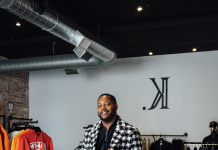On assignment for şÚÁĎÍř Detroit this month, photographer Viswanath “Veesh” Swamy captured stylish moments both on and off the New York Fashion Week spring/summer 2020 runway. Moving to the city to pursue a masters of science at Columbia University after graduating from Wayne State University in May 2018, the metro Detroit native has been practicing photography for four years. He’s shot the Detroit Institute of Arts’ Fash Bash, Detroit WALK Fashion Show, the Florence-based menswear event Pitti Immagine Uomo, as well as a previous NYFW. As for what made this fashion week different from the last one he covered, he says it was his level of experience. “I knew my equipment better, and I knew what to anticipate,” Swamy says. “Also, intuition is a critical and real thing. I’ve learned to follow my own when it comes to framing shots on the street or adjusting to the changing conditions of the runway.”
The result of this learned intuition is a body of work that captures the nonstop energy of the country’s fashion capital as well a hint at the styles of the moment. Here, he gives a behind-the-scenes look at the trends he spotted on the street and while shooting Cynthia Rowley’s spring/summer 2020 show, the draw of capturing an organic — and authentic — street style moment, and how NYFW is a testament to the fluid beauty of fashion.
şÚÁĎÍř Detroit: What are some of the fashion trends you were noticed while capturing street style and Cynthia Rowley’s show?
Viswanath Swamy:ĚýStreet style: Oversized tailoring but with a truly structured manner. I noticed a lot of women wearing slightly oversized tailored garments but securing it with a branded accessory, whether it’s a belt or handbag. Although there were a lot of traditionally known luxury markers (i.e. Louis Vuitton and Gucci), I noticed the call towards other young brands that have been making a splash into the traditional luxury world, namely Jacquemus and Balenciaga. Combined with the Cynthia Rowley show, I noticed a breath of color. I feel that color and oversized-ness will be tomorrow’s take on tailoring and structured garments.
What were you drawn to the most as a photographer?
The most critical thing I look for as a photographer isĚýhowĚýa person is wearing their garment. By this, I am referring to how that person claims their space through their clothing. I’ve always felt that clothing is an externalization of self; as a photographer, I thus am drawn towards identity and purpose in the choice of clothes. While this is difficult to accurately look for, what typically catches my eye is how people walk, their simple mannerisms in conversation, their hairstyle, their choice of accessories, etc. I like to imagine piecing together their stories through their clothing. With my love for tailoring, I do have a natural affinity towards noticing tailoring done well by both women and men. I also look for flamboyant colors and constructed pieces that I typically don’t see on the day-to-day. In other words, as much I love the classics done well, I am a sucker for the avant-garde and the “peacocks.”
How do you think street style has evolved?
I do think over the last five years (perhaps longer) or so there has been a greater presence of brand devotion and logos in the street. It begs the question of why some people feel a relationship with that brand: is it because of the logo itself or is it because they like the brand’s style? While I do think there is a degree of brand devotion that cannot be overlooked, I also feel that the “in-your-faceness” has minimized. I find greater brand subtlety in the garments themselves, while the accessories more or less have maintained their logo prevalence. For instance, some of the best looks I captured had an ambiguous designer name, but it was complemented by a Jacquemus or Balenciaga bag, or Manolo Blahnik heals (if you look very closely).
How has your approach to capturing street style changed over the years?Ěý
When I see people in the street, I like to capture them in their movement and how their garments flow with them as an extension. I try to bear witness rather than interfere with the moment. Previously, I always felt it’s necessary to stop a person and try to develop a rapport before taking a shot. However, I’ve found that the moment someone is told their photograph is being taken, the organic nature of the image is lost. It is quite natural to want to pose – to lookĚýgood. So, I’ve learned not to shoot like this. Instead, I just closely observe and move when I need to. The photographs that reveal that natural moment are the closest to reality.
What did you learn about fashion and style while covering NYFW this month?ĚýĚý
Covering NYFW this month has reinforced my belief that everyone has their own relationship to fashion, and it is essential to attempt to understand another’s vantage point. The beauty of fashion is that there is no single construct, and it is the fluidity of fashion that allows everyone to appreciate (and be appreciated by) it. Fashion week is a testament to this. Designers take what is known and flip it upside down, morph it, and reinvent it. By doing this, designers create a community of people that meet through a shared love of expressionism.
From The Archive:ĚýThe Gentleman’s Guide to Style
|
| Ěý |
|










